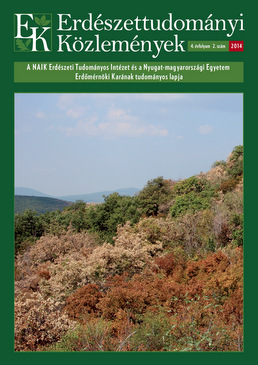| 1. | Berki I. 1995: Éghajlatunk változása és a hazai tölgypusztulás. In: Tar K.; Berki I. és Kiss Gy. (eds): Erdő és Klíma Konferencia. Noszvaj, 1994.06.01.–1994.06.03. KLTE, 217–221. |
| 2. | Bohár Gy. 1995: Krónikus és akut stresszállapot, valamint a másodlagos károsítók és kórokozók szerepe a kocsányos- és kocsánytalan tölgy, valamint a cser pusztulásában. In: Tar K.; Berki I. és Kiss Gy. (eds): Erdő és Klíma Konferencia. Noszvaj, 1994.06.01.–1994.06.03. KLTE, 222–229. |
| 3. | Borovics, A. and Mátyás, Cs. 2013: Decline of genetic diversity of sessile oak at the retracting (xeric) limits. Annals of Forest Science, 70: 835–844. DOI: 10.1007/s13595-013-0324-6 |
| 4. | Coart, E.; Lamote, V.; De Loose, M.; Van Bockstaele, E.; Lootens, P. and Roldán-Ruiz, I. 2002: AFLP markers demonstrate local genetic differentiation between two indigenous oak species [Quercus robur L. and Quercus petraea (Matt.) Liebl.] in Flemish populations. Theoretical and Applied Genetics, 105: 431–439. DOI: 10.1007/s00122-002-0920-6 |
| 5. | Curtu, A.L.; Gailing, O.; Leinemann, L. and Finkeldey, R. 2006: Genetic Variation and Differentiation Within a Natural Community of Five Oak Species (Quercus spp.). Plant Biology 9: 116–126. DOI: 10.1055/s-2006-924542 |
| 6. | Csóka Gy. 1992: A hazai kocsánytalantölgy-pusztulás menete 1983-tól napjainkig. Erdészeti Lapok, 127: 313–314. full text |
| 7. | Csóka Gy.; Koltay A.; Hirka A. és Janik G. 2007: Az aszályosság hatása kocsánytalan tölgyeseink és bükköseink egészségi állapotára. In: Mátyás Cs. és Vig P. (eds): Erdő és klíma V. kötet, Sopron, 229–239. |
| 8. | Gömöry, D. 2000: Gene coding for a non-specific NAD–dependent dehydrogenase shows a strong differentiation between Quercus robur and Quercus petraea. For. Genet., 7: 167–170. |
| 9. | Gömöry, D.; Yakovlev, I.; Zhelev, P.; Jedináková, J. and Paule, L. 2001: Genetic differentiation of oak populations within the Quercus robur/Quercus petraea complex in central and eastern Europe. Heredity, 86: 557–563. DOI: 10.1046/j.1365-2540.2001.00874.x |
| 10. | Hertel, H. and Degen, B. 2000: Distinguishing indigenous pedunculate and sessile oak (Quercus robur L. and Q. petraea [Mattuschka] Liebl.) using genetic and morphological traits. (Unterscheidung von Stiel- und Traubeneichen (Quercus robur L. und Quercus petraea [Mattuschka] Liebl.) mit Hilfe von genetischen und morphologischen Merkmalen). Forest Snow and Landscape Research, 75(1/2): 169–183. |
| 11. | Igmándy Z.; Béky A.; Pagony H.; Szontagh P. és Varga F. 1986: A kocsánytalan tölgypusztulás helyzete hazánkban 1985-ben. Az Erdő, 35: 255–259. full text |
| 12. | Igmándy Z.; Pagony H.; Szontagh P. és Varga F. 1984: Beszámoló a kocsánytalan tölgyeseinkben fellépett pusztulásról 1978-1983. Az Erdő, 33: 334–341. full text |
| 13. | Kampfer, S.; Lexer, C.; Glossl, J. and Steinkellner, H. 1998: Characterization of (GA), microsatellite loci from Quercus robur. Hereditas, 129: 183–186. DOI: 10.1111/j.1601-5223.1998.00183.x |
| 14. | Keresztesi B. (ed) 1990: A tölgyek komplex genetikai, taxonómiai és rezisztencia élettani kutatása, különös tekintettel a nemesítésre és az erdőpusztulásra. OTKA Zárójelentés, Budapest. |
| 15. | Mariette, S.; Cottrell, J.; Csaikl, U.M.; Goikoechea, P.; König, A.; Lowe, A.J.; van Dam, B.C.; Barreneche, T.; Bodenes, C.; Streiff, R.; Burg, K.; Groppe, K.; Munro, R.C.; Tabbener, H. and Kremer, A.. 2002: Comparison of levels of genetic diversity detected with AFLP and microsatellite markers within and among mixed Q. petraea (Matt.) Liebl. and Q. robur L. stands. Silvae Geneticae, 51: 72–79. |
| 16. | Müller-Starck, G. 1985: Genetic Differences between „Tolerant” and „Sensitive” Beeches (Fagus sylvatica L.) in an Environmentally Stressed Adult Foret Stand. Silvae Genetica, 34 (6): 241–246. |
| 17. | Müller-Starck, G. and Ziehe, M. 1991: Genetic variation in European populations of forest trees. Sauerländer’s Verlag. |
| 18. | Nei, M. 1972: Genetic distance between populations. American Naturalist, 106: 283–292. |
| 19. | Peakall, R. and Smouse, P. E. 2006: GENALEX 6: genetic analysis in Excel. Population genetic software for teaching and research. Molecular Ecology Notes, 6: 288–295. DOI: 10.1111/j.1471-8286.2005.01155.x |
| 20. | Rochel K. 1877: A csálai kincstári erdőgondnokság tölgyeseinek száradásáról. Erdészeti Lapok, 16: 553–556. full text |
| 21. | Sander, T.und Franke, A. 1999: Genetischer Vergleich geschädigter und nicht geschädigter Stiel- und Traubeneichenbestände (Quercus robur L. und Quercus petrea (Mattuschka) Liebl.) in Baden- Württemberg unter besonderer Berücksichtigung von Standort, Bestandesaufbau, bisheriger Bestandesbehandlung und anthropogenen Umweltbelastungen. Projektträgershaft. Programm Lebensgrundlage. Freiburg. |
| 22. | Sneath, P. H. A. and Sokal, R. R. 1973: Numerical Taxonomy. W.H. Freeman and Company, San Francisco, 230–234. |
| 23. | Standovár, T. and Somogyi, Z. 1998: Corresponding patterns of site quality, decline and tree growth in a sessile oak stand. European Journal of Forest Pathology, 28: 133–144. DOI: 10.1111/j.1439-0329.1998.tb01174.x |
| 24. | Steinkellner, H.; Fluch, S.; Turetschek, E.; Lexer, C.; Steiff, R.; Kremer, A.; Burg, K. and Gloessl, J. 1997: Identification and characterization of (GA/CT)n microsatellite loci from Quercus petraea. Plant Molecular Biology, 33: 1093–1096. DOI: 10.1023/A:1005736722794 |
| 25. | Vajna L. 1998: A fák nemspecifikus betegségek okozta elhalása erdei és gyümölcsös ökoszisztémában. Növényvédelem, 34 (5): 229–241. |
| 26. | Varga F. 1980: A tölgypusztulás Magyarországon. Erdészeti és Faipari Egyetem Tudományos Közleményei, 2: 11–17. |
